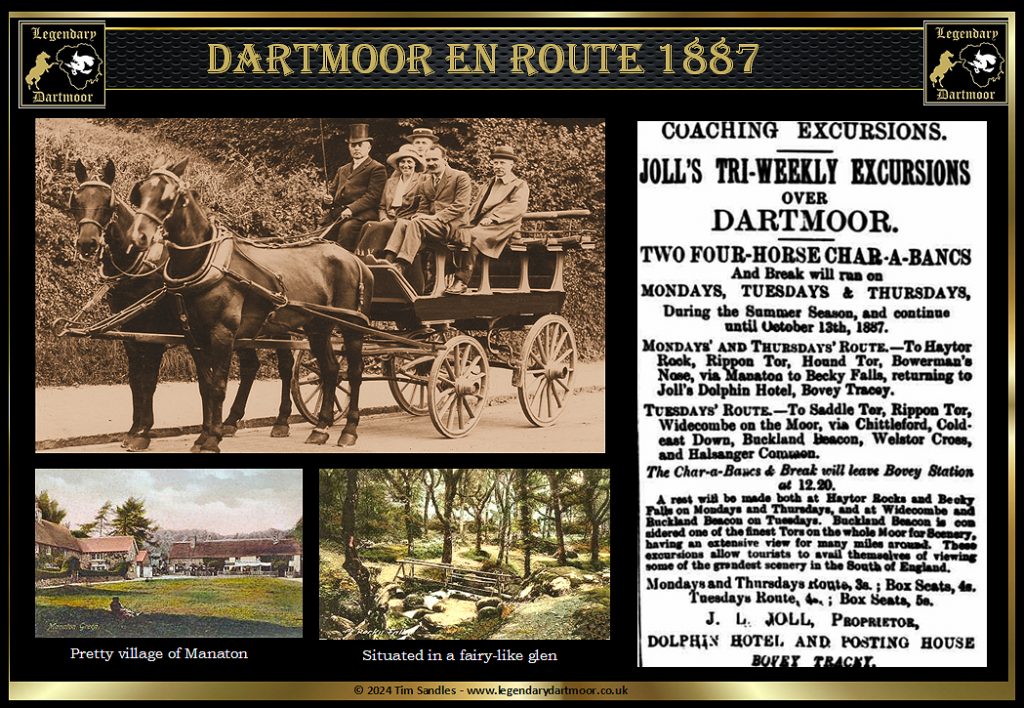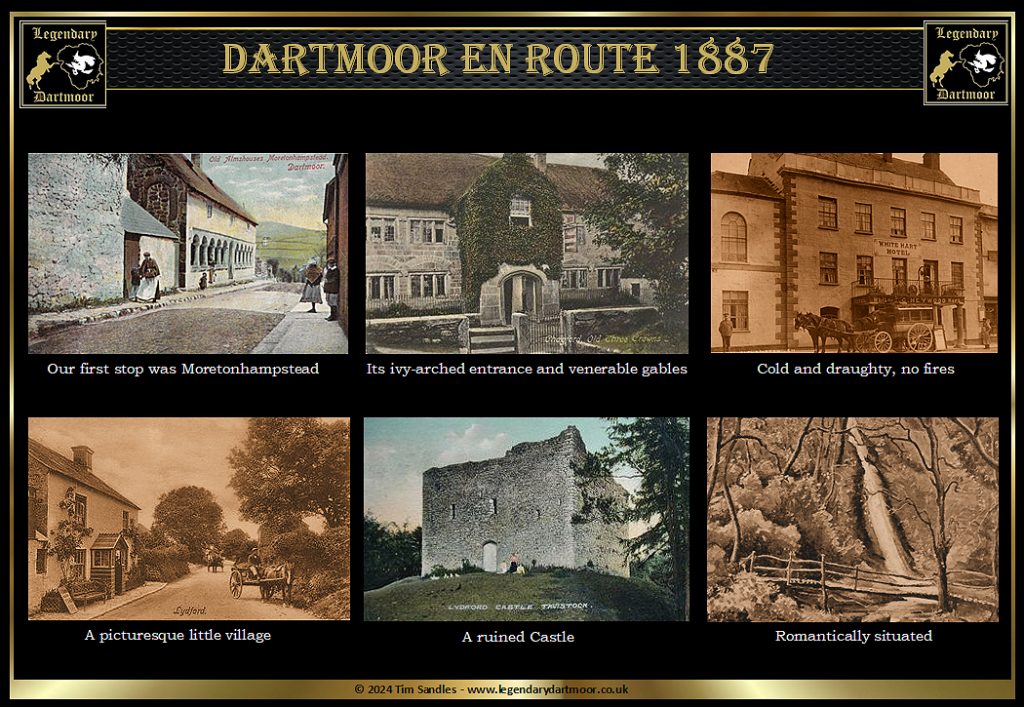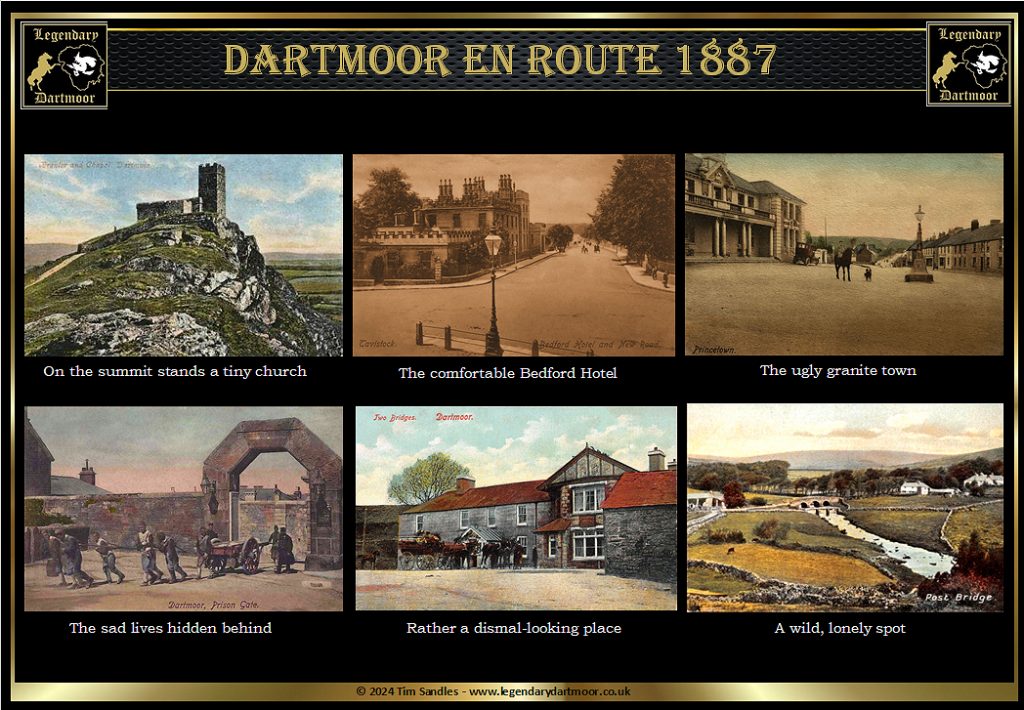
Imagine embarking on a three-day tour of Dartmoor with accommodation in some of the ‘finest’ hotels the area has to offer – sounds tempting? Now imagine a three-day tour of Dartmoor in September but travelling in an open top horse drawn carriage, along with other passengers, staying at the ‘finest’ hotels in 1887 – still sounding tempting? Well, this is what it was like –
“One September morning, when the sun was shining brightly, and the air delightfully fresh, we started from Newton Abbot, a pleasant little party of four, to join a coach at Bovey Tracey, for a three-day trip. A few minutes in the train brought us to our starting place, where we saw our travelling carriage awaiting us, under charge of the well-known driver. After scanning the faces of those who were to be our fellow travellers for the next day or two, which we did with some anxiety, for we knew we should be pretty closely packed, we were shown our places, which proved to be on the seat immediately behind the driver, quite the best on the coach. Alas! We knew we could not keep them all the time, as all must in fairness take that share of the back seat. Amidst the good wishes of a small crowd of villagers assembled to see us off and in high spirits, we started at a good pace. Our way lay through lovely lanes, sweet Devonshire lanes, verdant with ferns, whose variety would have delighted a botanist, while the overhanging trees were immediately above us on our elevated seat that unless one kept a sharp look out they were apt to give a sharp cut across the face, or at least to knock off one’s hat. Those at the back could not see what was in store for them, so we broke the ice by calling out timely warnings of “heads, “as we approached the bending boughs.
Our first stop was Moretonhampstead, a small town, with one struggling street, and nothing of interest of note but the surrounding country is very pretty, and we thoroughly enjoyed our four miles drive to Chagford, where we alighted about 2 p.m. for an hour and a halt. Luncheon was our first thought, the sharp air having given us an appetite, so we found a spreading willow tree, with seats under it, in the hotel garden which we thought a most tempting resting place, and there we did justice to the good things we had in our baskets, as one does with unaccustomed surroundings. It was a lovely day, so warm, so calm, one longed to linger, and idly dream away the sweet afternoon, but there was the church to be seen, and the town to be explored before setting off again. The church is of the Greystone so much used here, plain, and solid looking, it contains one of those curios narrow staircases used in olden times by the priests to get up to the rood screen, whence they blessed the people wandering in the churchyard, which is not only the resting place of the dead but a busy thoroughfare for the living. We were struck by the longevity of the inhabitants of Chagford, eighty-seven, and ninety seemed quite common inscriptions on the gravestones, and some approached nearer to the centennial. It looks as if the little moorland town were favourable for long life, elevated as it is above the sea level, yet sheltered by the high tors which surround it. Many people come here for their health, and there are plenty of lodgings and some hotels. One of the latter, The Three Crowns is most picturesque with its ivy-hung arched entrance and venerable gables.
We were soon en route once more for Okehampton, which we reached at 6 p.m., after passing through some grand scenery, wilder and more imposing than the morning’s lovely drive. The Dartmoor hills, with their rocky summits loomed dark and massive on our left, while the sun, fast setting behind their purple ridge, tinted the clouds with most exquisite hues of gold and crimson, to the delight of the more artistic of our party. The White Hart Hotel we found clean and comfortable; but oh! cold and draughty, no fires, it being still September, though the evening was chilly. We retired early, hoping to find warmth in bed, which we very successfully did, and in consequence did not rise in such good time as we meant to have done. Some of our fellow tourists breakfasted early and started off to see the ruined castle of Okehampton, while we (prosaic souls) only thought of providing our lunch. The coach was underway at 10.30, and we found ourselves on the back seat of all, a bad change after yesterday; still, we were better off than our opposite neighbours who had their backs to the horses and must have felt truly uncomfortable in such a seat. The road ascended through charming lanes; the banks so high that even from our elevated position we could not see the lovely landscape beyond. Yet who could quarrel with such a screen? Ferns grew in richest abundance, above were tangles of foliage, and berries in marvellous shades of vivid red and purple, while now and then came an opening through which we had glimpses of the fair undulating country, painted in the rip soft colouring of a perfect autumn morning.
Our first halt was at Lydford, once an important place, represented in Parliament, now but a picturesque little village with a ruined castle and an ancient church, which we inspected, a curious building, very small and old: the churchyard commands a fine view. Down a steep lane we went to Lydford Bridge, which spans a deep gorge, and here some of our party left the coach to walk through the glen and re-join us at our mid-day halt; it was a rough walk of two miles, and we on the coach thought ourselves best off, fro the drive was very pretty, and owing to the absence of our friends we had more room. After our picnic lunch we went to see the Lydford Cascade, romantically situated in an exquisite glen with high slopes covered with trees just taking the ruddy tints of autumn; below the little river bubbled along beneath overhanging branches. The afternoon drive was perhaps less pretty than the morning one, but more comfortable, some of our party having gone by rail. Presently we came to Brent Tor, a high bare hill, on the summit of which stands a little church, built in fulfilment of a vow by someone in danger of shipwreck. After this we proceeded without further adventure down a steep hill to Tavistock, tired and glad to settle ourselves in the comfortable Bedford Hotel. And so to bed, as old Pepys would say.
Next morning the coachman fixed ten o’clock as the hour of starting, having a long day before us; so there was little time to see the historical town of Tavistock, with its ancient abbey and fine church. We found time, however, for a hasty look at the latter, which contains some interesting monuments and has a beautiful peal of bells. The first part of our drive was very pretty, taking us along well-kept roads, past pretty houses set in gardens full of flowers; but soon the scene changed, and we found ourselves on the bleak moorland, ascending higher and higher, the air growing colder and colder. The warm wraps, despised hitherto, were now unfolded, and hastily put on. The scene was desolate in the extreme. For miles round stretched the barren moors; the lofty tors, with their curious Druidical stones, frowned above our road, and a stormy grey sky gave effect to the picture. At last we came to Princetown, where is the Dartmoor prison, such a gloomy pile. It was depressing to look at its cold grey walls, and to think of the sad lives hidden behind them; the ugly granite town, treeless, and flowerless, looked so uninviting that I think none of us were sorry to leave it behind, though I believe many people take some rooms here in summer for the sake of the fine air. We seemed here to be in mid-winter, so piercing was the wind; and very glad we were to see a fire burning when we alighted at the Two Bridges Hotel, rather a dismal-looking place, we thought, but the visitor’s book showed a goodly list of tourists, who speak in high praise of this hostelry. Warmed by the fire and some hot strong coffee, we sallied forth to explore and found some fine views of moorland scenery within a very short walk. A little further was Wistman’s Wood, but time did not allow us to reach it.
We were soon again en route toiling up an immensely long hill, through miles of bold and rugged scenery, most bleak and desolate, vast masses of granite crowning the hills, while a keen wind whistled around us. At last we got to a village called Post Bridge – a wild, lonely spot, up a little higher, and then we began to descend, getting down by degrees to a more genial temperature and more cultivated lands, till at length were in the lovely lanes once more, with their high banks and tall hedges gemmed with the brightest of berries growing in wonderful luxuriance. We passed through the pretty village of Manaton, and a halt was made to allow us to see Becky Falls, which have very little water, but are charmingly situated in a fairy-like glen. We should have liked to linger in this sylvan shade, so refreshing after the wild desolation we had passed, but the sun was getting low, and there were still some miles before us. The rest of the drive was lovely, the sunset hues on trees and hedges, rocks, and heather-clothed hills, and soon we could see the little inn at Bovey, where our good coachman brought us safe and sound after a most enjoyable trip of three days through beautiful and interesting country. Here we and our companions de voyage took a courteous farewell of each other, departing our several ways, and all agreeing that, given fine weather, there could be no pleasanter way of taking a holiday and seeing the fine scenery than spending a few days on the top of a well-horsed coach.”
One such “well-known driver” was Mr. Joll the owner of the Dolphin Hotel at Bovey Tracy who ran regular excursions whilst also catering for private parties. Initially in the summer months he ran trips around the Haytor area. Then in 1885 it was announced that he had purchased a purpose-made, state of the art coach for these trips. This new black and vermilion painted coach was drawn by four horses and capable of accommodating 21 passengers seated on front facing seats and was said to safe, strong and run lightly. Apparently he was a; “noted whip, if possible, who generally manages to take charge of the ribbons on these occasions, and being of a very agreeable disposition, is ever ready to point out any object of interest. He is also very attentive to the fair sex dispensing with the pipe, whose fumes are so annoying to those of tender years. It is no wonder then, that he is a general favourite among the ladies. Hence a more pleasant or inexpensive outing cannot be contemplated.” By the following year Mr. Joll was running two charabancs called the ‘Original’ and the ‘Victoria’. The four horses pulling the ‘Original’ were called; Prince, Manaton Grey, Peter and Doctor the lead horse. Unfortunately the author of the above account does not clarify exactly who organised this particular three day excursion but in all probability it was Mr. Joll. I take it one could assume that the general impression of the Dartmoor landscape being that it was pretty and lovely 🙂
 Legendary Dartmoor The many aspects past and present of Dartmoor
Legendary Dartmoor The many aspects past and present of Dartmoor



